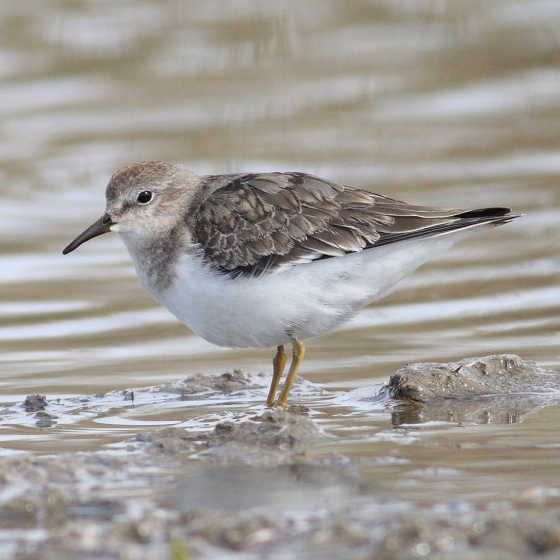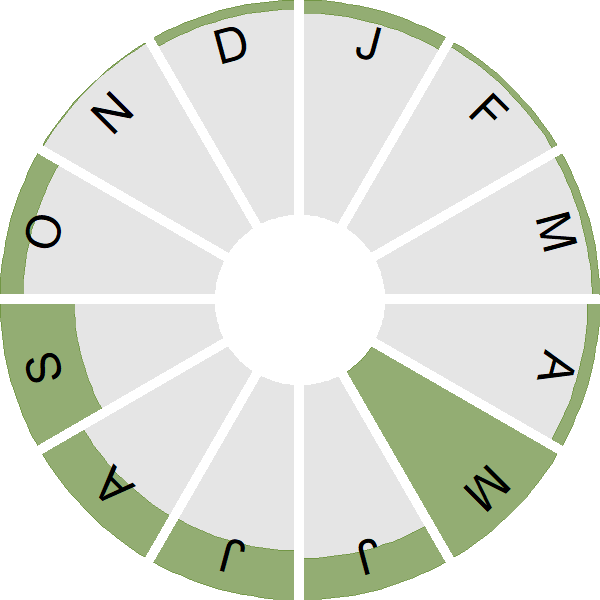Temminck's Stint

Introduction
This diminutive wader is a passage migrant and exceptionally rare breeder.
At the very south-western edge of its breeding range, there were only ever a very small number of individuals breeding in northern Scotland in any one year, but even these numbers have declined and it now appears to breed less than annually. Favoured breeding sites were in remote, damp, bogs.
It is most frequently recorded in BirdTrack in the spring (most records are in May) as individuals make the return journey from their wintering grounds in Africa. Records are usually of single birds since this species does not readily form flocks in the way that other waders do.

Key Stats
Identification
Songs and Calls
Flight call:
Status and Trends
Conservation Status
Population Change
Population trends of this scarce species are not routinely monitored.
Distribution
Temminck's Stints have bred on occasion in the UK, but none were confirmed to breed during the 2007–11 atlas.
Occupied 10-km squares in UK
2007/08–10/11
or view it on Bird Atlas Mapstore.
2008–11
or view it on Bird Atlas Mapstore.
European Distribution Map
Distribution Change
Change in occupied 10-km squares in the UK
from 1981–84 to 2007–11
or view it on Bird Atlas Mapstore.
from 1968–72 to 2008–11
or view it on Bird Atlas Mapstore.
Seasonality
Temminck's Stints are scarce passage migrant, regularly recorded in May and sporadically in autumn and rarely in winter.
Weekly pattern of occurrence
The graph shows when the species is present in the UK, with taller bars indicating a higher likelihood of encountering the species in appropriate regions and habitats.

Movement
Britain & Ireland movement
Foreign locations of birds ringed or recovered in Britain & Ireland
Dots show the foreign destinations of birds ringed in Britain & Ireland, and the origins of birds ringed overseas that were subsequently recaptured, resighted or found dead in Britain & Ireland. Dot colours indicate the time of year that the species was present at the location.
- Winter (Nov-Feb)
- Spring (Mar-Apr)
- Summer (May-Jul)
- Autumn (Aug-Oct)

European movements
EuroBirdPortal uses birdwatcher's records, such as those logged in BirdTrack to map the flows of birds as they arrive and depart Europe. See maps for this species here.
The Eurasian-African Migration Atlas shows movements of individual birds ringed or recovered in Europe. See maps for this species here.
Biology
Productivity and Nesting
Nesting timing
Egg measurements
Clutch Size
Survival and Longevity
Survival is shown as the proportion of birds surviving from one year to the next and is derived from bird ringing data. It can also be used to estimate how long birds typically live.
View number ringed each year in the Online Ringing Report.
Lifespan
Survival of adults
Biometrics
Wing length and body weights are from live birds (source).
Ring Size
Classification, names and codes
Classification and Codes
- Order: Charadriiformes
- Family: Scolopacidae
- Scientific name: Calidris temminckii
- Authority: Leisler, 1812
- BTO 2-letter code: TK
- BTO 5-letter code: TEMST
- Euring code number: 5020
Alternate species names
- Catalan: territ de Temminck
- Czech: jespák šedý
- Danish: Temmincksryle
- Dutch: Temmincks Strandloper
- Estonian: värbrüdi e. värbrisla
- Finnish: lapinsirri
- French: Bécasseau de Temminck
- German: Temminckstrandläufer
- Hungarian: Temminck-partfutó
- Icelandic: Bakkatíta
- Irish: Gobadáinín Temminck
- Italian: Gambecchio nano
- Latvian: (Teminka šnibitis), pelekais trulitis
- Lithuanian: Teminko begikas
- Norwegian: Temmincksnipe
- Polish: biegus maly
- Portuguese: pilrito-de-temminck
- Slovak: pobrežník sivý
- Slovenian: Temminckov prodnik
- Spanish: Correlimos de Temminck
- Swedish: mosnäppa
- Welsh: Pibydd Temminck
More Evidence
More evidence from Conservation Evidence.com
Partners
Citing BirdFacts
If you wish to cite particular content in this page (e.g. a specific value) it is best to use the original sources as linked in the page. For a more general citation of the whole page please use: BTO (20XX) BirdFacts Species: profiles of birds occurring in the United Kingdom. BTO, Thetford (www.bto.org/birdfacts, accessed on xx/xx/xxxx).

